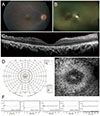Dear Editor,
Bardet-Biedl syndrome (BBS) is a rare, autosomal recessive ciliopathy characterized by retinal dystrophy, obesity, post-axial polydactyly, renal dysfunction, learning difficulties, and hypogonadism. Genes involved in BBS encode proteins that are localized to the cilia and basal body and are involved in cilia biogenesis and function [1]. A total of 21 causative genes has been discovered for BBS to date, and their proteins are thought to play a role in protein trafficking and in function of the photoreceptor connecting the cilium and outer segment [2]. This is the first case report of BBS9 gene mutation causing BBS and retinitis pigmentosa.
A 14-year-old Korean boy was referred to our ophthalmology clinic with night blindness and decreased visual acuity and visual fields in both eyes for four years. He was previously diagnosed with retinitis pigmentosa in both eyes at another ophthalmology clinic. At the initial examination, his corrected visual acuity was 16 / 20 in the right eye and 6 / 20 in the left eye. No abnormality in the anterior segment was noted on slit lamp examination. Fundoscopic examination revealed macular retinal pigment epithelium atrophy and diffuse mid-peripheral depigmentation (Fig. 1A, 1B). Spectral-domain optical coherence tomography (Spectralis; Heidelberg Engineering, Heidelberg, Germany) showed generalized thinning of the neural retina and markedly attenuated photoreceptor layers (Fig. 1C). Goldmann perimetry showed that the central island could only be measured within 5° center of the visual field (Fig. 1D). Fundus autofluorescence imaging demonstrated concentric regions of hyper- and hypo-autofluorescence in the macula, with a surrounding zone of hyper-autofluorescence, giving a complex bull's-eye-like pattern (Fig. 1E). Electroretinography was non-recordable (Fig. 1F). The patient's dysmorphic features included obesity, genital anomalies, diabetes mellitus, and brachydactyly. Surgical treatment (Roux-en-Y gastric bypass) was performed for severe obesity (body mass index, 44.94), We performed next generation sequencing based gene panel sequencing targeting inherited retinal diseases and identified two novel mutations of the BBS9 gene coding sequence: one missense mutation (c.779T>G [p.Val260Gly]) and one truncation mutation (c.2419C>T [p.Gln807Ter]), which genetically confirmed the diagnosis of BBS. At his last visit, the patient's visual acuity involved no light perception with a posterior subcapsular cataract and diffuse retinal degeneration in both eyes.
The frequency of BBS in Europe and North America is lower than 1 : 100,000, whereas it is relatively common in the Middle East, with a frequency of 1 : 13,500. BBS is typically diagnosed based on known symptoms, but identification of BBS gene mutations could enable genetic diagnosis of affected patients as well as carriers [3]. BBS is currently treated symptomatically, focusing on aggressive management of diabetes, hypertension, and metabolic syndrome to minimize secondary impact to vulnerable organs. In Korea, Shin et al. [4] identified mutations of the BBS7 gene (c.103-1G>A, c.728G>A [p.Cys243Tyr]), and Yoon et al. [5] identified BBS10 gene mutations (c.530A>G [p.Y177C], c.235_236insA [p.T78Nfs*17]) in BBS patients.
In the BBS9 gene, valine in the 260th amino acid sequence is well preserved in mammalian species, and the p.V260G mutation reported in this case is an extremely rare variant not detected in general populations. The in silico prediction using Polyphen-2, PROVEAN, SIFT, and Mutation Taster indicates damaging pathogenicity. The second truncation mutation (c.2419C>T [p.Gln807Ter]) is located close to the PHTB1 c-terminus domain that forms the BBSome complex, which is involved in vesicular trafficking of the Rab8-Rabin8-Rab11 cascade and ciliogenesis.
It is not known whether these two different variants are located on different alleles (in trans, compound heterozygosity), as familial samples could not be obtained. However, considering the extreme rarity of these variants and the recessive traits of BBS, it is presumed that each variant of BBS9 gene acts as a loss-of-function mutation in development of BBS.
In summary, we report ophthalmic and systemic features of the first Korean case of BBS caused by BBS9 gene mutations, which we confirmed through genetic identification of two novel variants of the BBS9 gene.
Figures and Tables
Fig. 1
(A,B) Fundus photography and ultrawide-field fundus photography of the right eye showing waxy pallor of the disk, vascular attenuation, macular retinal pigment epithelium atrophy, and diffuse mid-peripheral depigmentation. (C) Spectral-domain optical coherence tomography of the right eye showing generalized thinning of the neural retina, especially photoreceptor layers. (D) Goldmann perimetry of the right eye showed a central island that only measured within center 5° of the visual field. (E) Fundus autofluorescence imaging of the right eye showed concentric regions of hyper- and hypo-autofluorescence in the macula, resulting in a complex bull's eye-like pattern. (F) Electroretinography showed no a- and b-wave amplitudes.

Acknowledgements
This study was supported by the National Research Foundation (NRF) Bio & Medical Technology Development Program (Grant No. 2018M3A9B5021319) funded by the Korean government (MSIP and MSIT). The funding organization had no role in the design or conduct of this study.
References
2. Weihbrecht K, Goar WA, Pak T, et al. Keeping an eye on Bardet-Biedl syndrome: a comprehensive review of the role of Bardet-Biedl syndrome genes in the eye. Med Res Arch. 2017; 09. 18. DOI: 10.18103/mra.v5i9.1526.
4. Shin SJ, Kim M, Chae H, et al. Identification of compound heterozygous mutations in the BBS7 gene in a Korean family with Bardet-Biedl syndrome. Ann Lab Med. 2015; 35:181–184.


5. Yoon SC, Lee HJ, Ko JM, et al. Two siblings with Bardet-Biedl syndrome caused by mutations in BBS10: the first case identified in Korea. J Genet Med. 2014; 11:31–35.




 PDF
PDF ePub
ePub Citation
Citation Print
Print


 XML Download
XML Download